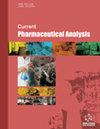分析科学实施设计质量的陷阱与机遇
IF 1.5
4区 医学
Q4 PHARMACOLOGY & PHARMACY
引用次数: 0
摘要
设计质量(QbD)是一种与质量风险管理相结合的系统方法。它使用不同的设计方法,然后进行统计分析,以产生高质量的产品。现在,制药行业热衷于将QbD原理应用于分析方法,并将其称为分析QbD(AQbD),这本质上并不意味着更少的分析测试;在某种程度上,它意味着在正确的时间进行正确的分析,并得到科学和风险评估的支持,从而确保分析方法在整个生命周期内都能得到改进。然而,为此,分析员必须对分析目标剖面(ATP)、方法性能特征、风险评估、实验设计(DoE)的选择、方法可操作设计区域(MODR)的优化有充分的了解。一些论文引用了AQbD的重要性、监管灵活性、理论方面和统计分析,但仅讨论了在分析科学中逐步实施QbD的核心问题。对于无缝过渡,研究人员需要澄清AQbD术语、可接受的方法、反映关键质量属性(CQA)的标准以及判断控制是否充分的标准。本文总结了AQbD实施面临的挑战和解决方案。本文章由计算机程序翻译,如有差异,请以英文原文为准。
Pitfalls and Opportunities in the Execution of Quality by Design in Analytical
Sciences
Quality by Design (QbD) is a systematic approach integrated with quality risk management.
It uses different design approaches followed by statistical analysis to yield a quality
product. Now, the pharmaceutical industries are intrested in the application of QbD principles to
analytical methods and term it as Analytical QbD (AQbD), which does not essentially mean less
analytical testing; to a particular extent, it means the right analysis at the right time, supported by
science and risk evaluation which ensures that the analytical method can be improved throughout
its life cycle. However, for that, the analyst must have sound knowledge of Analytical Target Profile
(ATP), method performance characteristics, risk assessment, choice of Design of Experiment
(DoE), optimization of Method Operable Design Region (MODR). Some papers have cited the
importance, regulatory flexibility, theoretical aspects, and statistical analysis of AQbD, but only a
few discuss the core issue of gradual implementation of QbD in analytical sciences. For seamless
transition, researchers need clarification on AQbD terminologies, acceptable methods, criteria to
embrace critical quality attributes (CQAs), and standards to judge the adequacy of controls. This
paper summarizes the challenges and solutions for the implementation of AQbD.
求助全文
通过发布文献求助,成功后即可免费获取论文全文。
去求助
来源期刊
CiteScore
1.50
自引率
0.00%
发文量
85
审稿时长
3 months
期刊介绍:
Aims & Scope
Current Pharmaceutical Analysis publishes expert reviews and original research articles on all the most recent advances in pharmaceutical and biomedical analysis. All aspects of the field are represented including drug analysis, analytical methodology and instrumentation. The journal is essential to all involved in pharmaceutical, biochemical and clinical analysis.

 求助内容:
求助内容: 应助结果提醒方式:
应助结果提醒方式:


